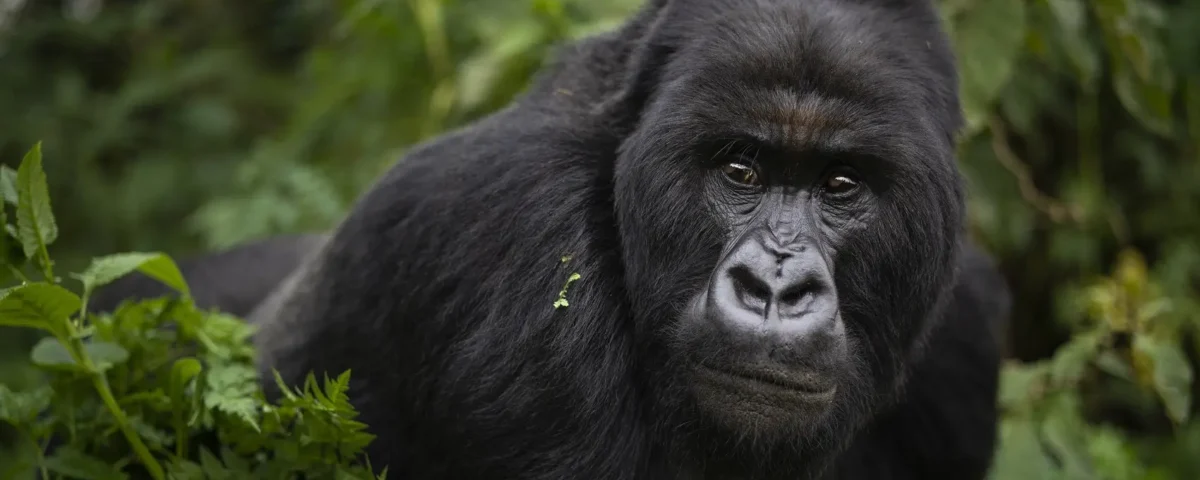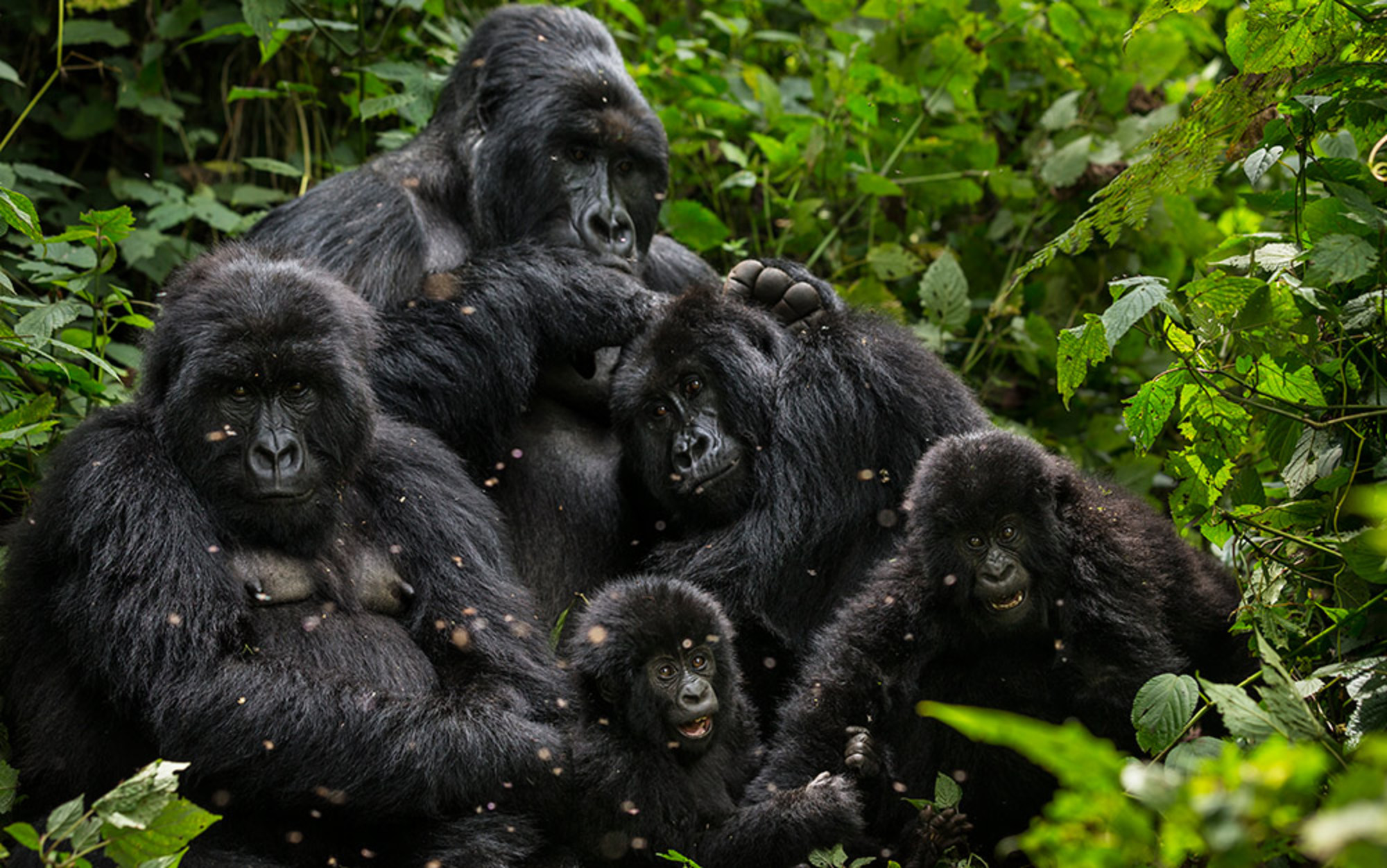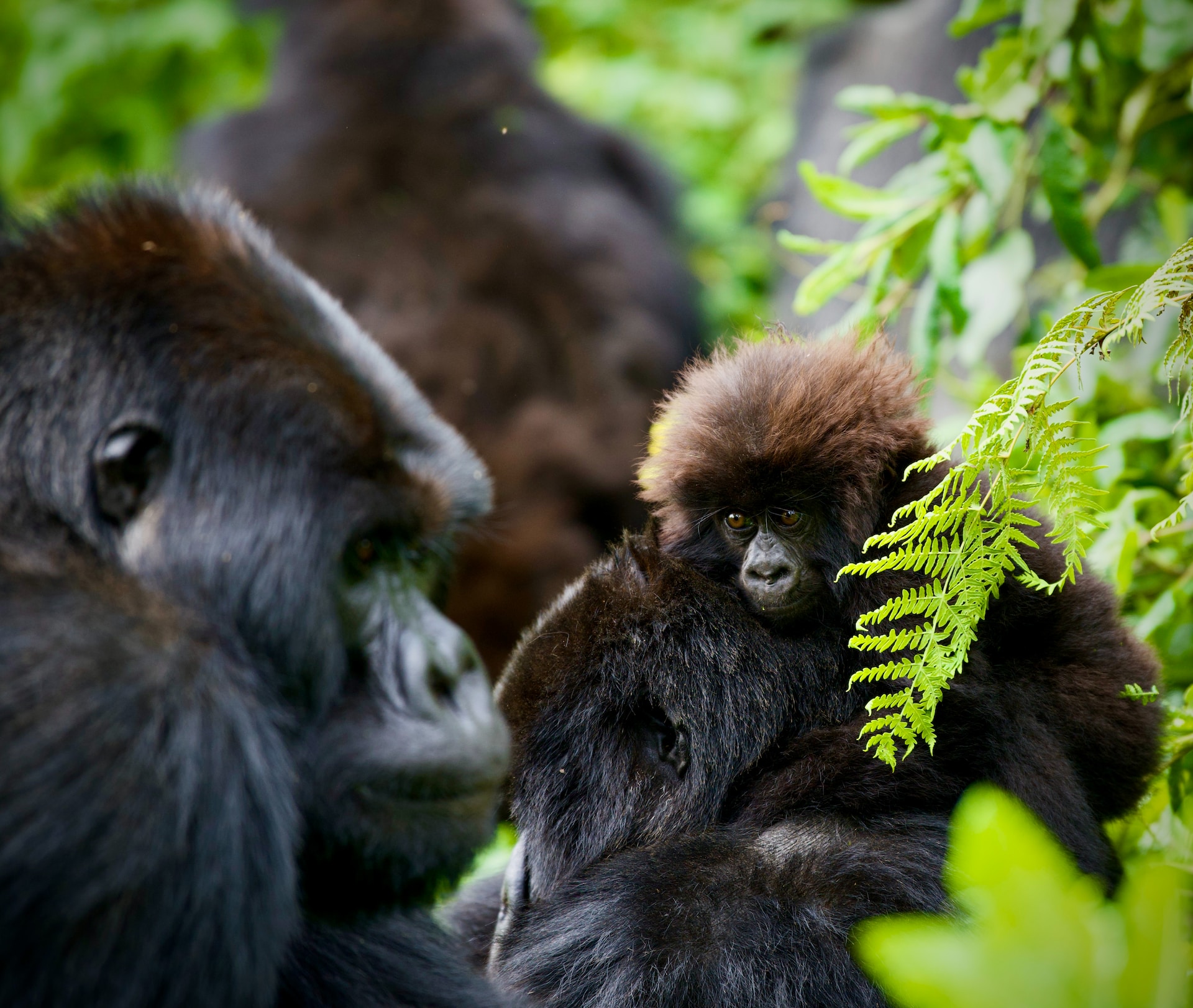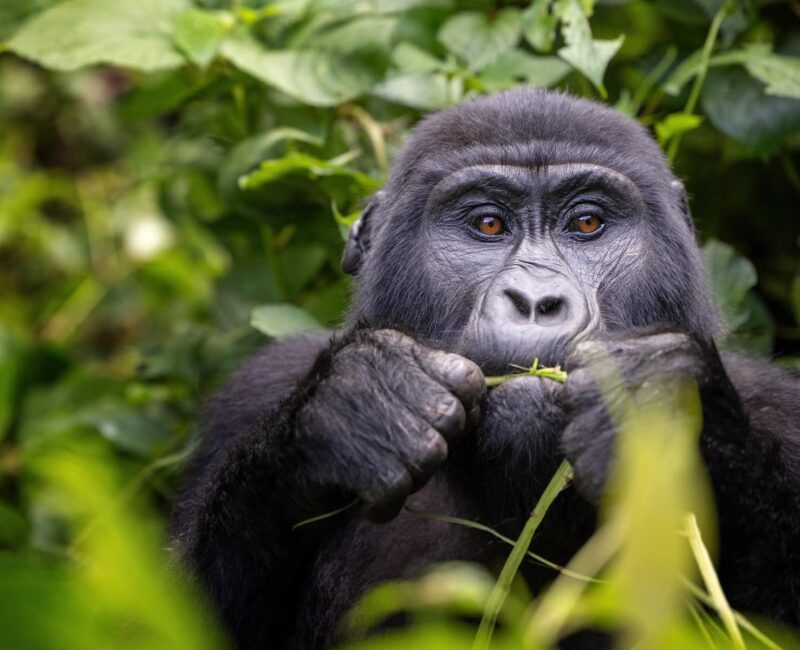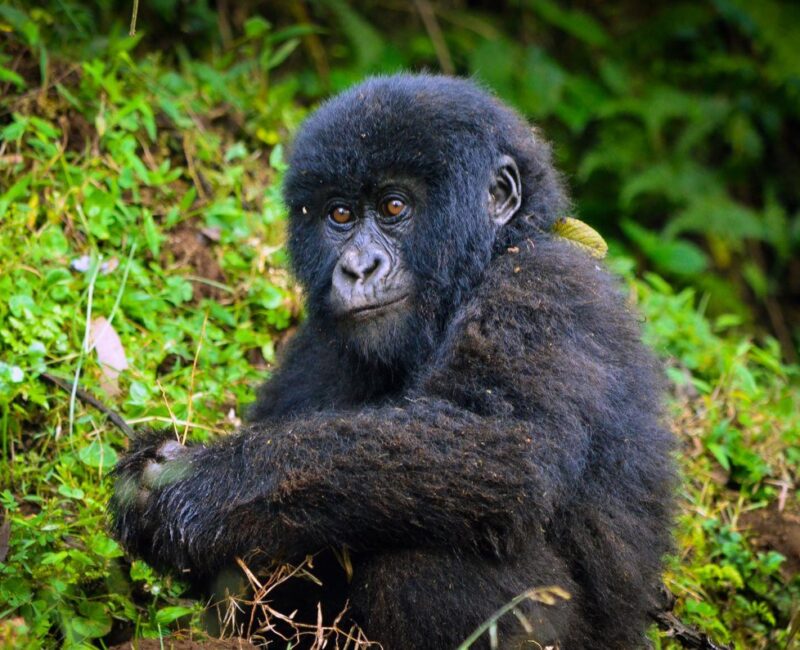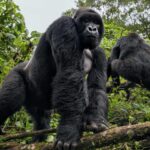
Inside The Gorilla Family
September 30, 2025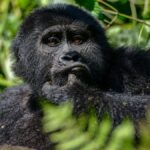
Gorilla Behavioral Adaptations
September 30, 2025Co-existence of Gorilla Families in Uganda: Understanding Dynamics in Bwindi and Beyond
Why Gorilla Families in Uganda Fascinate Travelers
Uganda is celebrated worldwide for its remarkable mountain gorillas, found primarily in Bwindi Impenetrable National Park and Mgahinga Gorilla National Park. Tourists seeking once-in-a-lifetime adventures choose Uganda for its unique blend of wildlife and cultural experiences. Beyond the iconic activity of Uganda Gorilla Trekking, visitors often ask deeper questions: how do gorilla families live, and how do they coexist within the same forest environment?
The co-existence of gorilla families in Uganda is a captivating subject because it sheds light not only on gorilla behavior but also on conservation strategies that make Uganda Gorilla Safaris so successful. Gorilla families, also called groups, exhibit intriguing social dynamics. Some families split into smaller units yet remain in the same region, while others thrive with multiple silverbacks peacefully sharing leadership. This ability to coexist within a shared environment makes Uganda’s gorilla population one of the most interesting to study and experience.
Travelers on Uganda Safaris Holidays quickly realize that observing gorilla families offers much more than simply spotting wildlife. It provides valuable insights into family bonds, leadership struggles, and survival strategies in the wild. By understanding these dynamics, tourists not only appreciate their trekking encounters more deeply but also connect with the broader importance of conservation efforts.
For those planning Uganda Tours or considering a Uganda Safari Holiday, learning about gorilla coexistence makes the trekking adventure richer and more meaningful. It turns each encounter into a lesson about nature’s resilience and adaptability.
Peaceful Interaction: How Gorilla Families Share Space
Gorilla families in Uganda demonstrate a fascinating balance between independence and cooperation. Some families live in overlapping territories without constant conflict, showing remarkable tolerance for neighbors. In Bwindi Impenetrable National Park, families occasionally cross paths, and while tension is possible, many interactions remain surprisingly peaceful.
A good example lies in the Bitukura family, which thrives with multiple silverbacks maintaining a harmonious leadership structure. This is rare among primates but highlights the adaptability of gorillas. Observing such interactions during a Uganda Gorilla Safari gives trekkers a chance to witness family structures that mirror human cooperation and coexistence.
Peaceful encounters between groups also allow tourists to enjoy more rewarding trekking experiences. Guides can explain the nuances of these relationships during Uganda Wildlife Safaris, helping visitors understand how such dynamics play a role in population stability. For travelers, these lessons reinforce the idea that gorillas are not just wildlife—they are communities with rich social structures.
The peaceful coexistence of gorilla families is not guaranteed, yet when it happens, it underscores the success of conservation strategies and the natural intelligence of these primates. It is one of the most fascinating aspects to witness during Uganda Gorilla Trekking.
Breakaway Groups: How New Families Form
Large gorilla families often split when the group becomes too big for resources or social harmony. This process, known as a fission, creates new breakaway families that remain in the same region, increasing the number of groups within an area.
A classic example comes from the Nshongi group, once the largest habituated gorilla family in Bwindi. Over time, the group experienced peaceful splits, leading to the creation of new families such as Mishaya. Interestingly, Mishaya remained within the Rushaga sector, leading to the coexistence of multiple families in the same landscape.
For tourists, this creates exciting opportunities. On Uganda Gorilla Safaris in Rushaga, trekkers might be assigned to different breakaway groups, each offering unique encounters. One trek may reveal a family dominated by a single silverback, while another trek may highlight a younger group still establishing its identity.
These breakaway dynamics ensure constant evolution within gorilla populations, providing fresh experiences for travelers on repeated Uganda Safari Holidays. Unlike static wildlife tours, gorilla trekking in Uganda allows tourists to witness dynamic changes in family structures, making each visit truly unique.
Leadership Structures: The Role of Silverbacks
Leadership is central to gorilla family coexistence. Silverbacks, the dominant males, protect family members, mediate conflicts, and decide movement routes. Some families are led by a single powerful silverback, while others demonstrate dual or shared leadership.
The Busingye family provides an interesting case. Within this group, more than one silverback contributes to decision-making, showing that leadership can be cooperative rather than competitive. Such structures minimize conflict and allow for larger groups to thrive.
For visitors on Uganda Gorilla Trekking tours, observing leadership dynamics adds depth to the experience. Watching a silverback maintain order or observing subordinates respect boundaries highlights the discipline and intelligence within gorilla families. These insights go beyond the excitement of seeing gorillas up close; they enrich travelers’ appreciation for wildlife behavior.
On a broader scale, understanding leadership patterns is vital for conservationists managing habituated families. It ensures that gorilla tourism, a cornerstone of Uganda Wildlife Safaris, remains sustainable and respectful of gorilla social systems. For tourists, witnessing these dynamics makes a Uganda Safari Holiday both educational and unforgettable.
Regional Proximity: Families Living Close Together
Gorilla families in Uganda often remain in the same regions of Bwindi, such as Rushaga, Nkuringo, or Ruhija. This proximity leads to overlapping home ranges, making coexistence an essential survival strategy.
For example, the Nkuringo group gave rise to new families like Bushaho and Bikingi, both undergoing habituation within the same region. Tourists trekking in Nkuringo may find themselves near several families, creating diverse trekking opportunities. Similarly, in Ruhija, families like Bitukura and Kyaguriro demonstrate how close living can result in peaceful coexistence rather than rivalry.
For travelers, this regional proximity means flexibility. Tour operators can assign trekkers to different families depending on fitness levels, availability of permits, and interest in particular gorilla dynamics. A Uganda Safari Holiday in Bwindi, therefore, offers unmatched variety compared to other destinations.
The clustering of families also enhances conservation monitoring. Rangers and researchers can observe multiple families within manageable areas, ensuring better protection. This contributes to the overall success of Uganda Gorilla Safaris and demonstrates how coexistence benefits not only gorillas but also eco-tourism.
Examples of Coexistence in Uganda’s Gorilla Families
Uganda provides multiple case studies of gorilla coexistence:
- Mishaya and Nshongi: Mishaya broke away from Nshongi but continues to thrive in the Rushaga sector, proving peaceful regional coexistence is possible.
- Nkuringo and Breakaway Groups: The Nkuringo family produced Bushaho and Bikingi, now undergoing habituation, showing how parent groups can lead to new families within the same environment.
- Bitukura and Kyaguriro: These families have shared peaceful interactions in Ruhija, highlighting tolerance between neighboring groups.
- Mukiza and Kyaguriro: After the death of silverback Rukina, Mukiza emerged as leader of a new family while still coexisting in the same region.
For tourists, these examples are more than scientific notes, they are living stories encountered during Uganda Gorilla Trekking. Each trekking experience becomes an opportunity to observe real-life family dramas, peaceful bonds, and survival strategies. This is what makes a Uganda Gorilla Safari extraordinary compared to standard Uganda Wildlife Tours.
Factors Influencing Coexistence Among Gorilla Families
Several factors shape the coexistence of gorilla families in Uganda:
Conservation Efforts: Intensive conservation programs and revenue from gorilla trekking have expanded protection for gorillas, ensuring they have sufficient space to coexist.
Tourism Revenue: Funds from gorilla permits directly support habitat protection, anti-poaching patrols, and community projects. This strengthens the balance between gorilla conservation and human development.
Human Habituation: While gorillas remain wild, habituation allows them to tolerate human presence, making Uganda Gorilla Safaris possible without disrupting their natural behavior.
Conservation of Habitat: Bwindi and Mgahinga are protected areas, preventing habitat loss and encouraging peaceful gorilla coexistence.
For travelers, these factors ensure sustainable tourism. Participating in Uganda Safaris Holidays not only guarantees life-changing encounters but also contributes directly to conservation, making gorilla trekking both an adventure and a responsibility.
Cultural Experiences Around Safari Lodges
Beyond gorilla trekking, lodges around Bwindi and Mgahinga offer cultural experiences that enrich Uganda tours. Visitors can meet the Batwa people, traditional forest dwellers, and learn about their heritage through guided cultural trails.
Guests also enjoy local dance performances, storytelling evenings, and village tours. These cultural activities complement Uganda Gorilla Safaris, giving travelers a holistic safari holiday that combines wildlife with human heritage. Lodges often organize craft workshops and cooking experiences, allowing tourists to engage directly with local communities.
Including these cultural activities in a Uganda Safari Holiday adds depth to the journey, ensuring visitors leave with a broader understanding of Uganda’s diverse heritage. This integration of wildlife and culture makes Uganda Safaris truly unique compared to other African safari destinations.
The Meaning of Gorilla Coexistence in Uganda
The co-existence of gorilla families in Uganda represents one of the most fascinating aspects of primate life. Families split, reform, and adapt, yet they continue to thrive within the same forests of Bwindi and Mgahinga. For travelers, this coexistence provides not only a chance to observe gorillas but also to understand the resilience and intelligence of these primates.
Adding this knowledge to a Uganda Gorilla Safari transforms trekking from simple wildlife viewing into an educational journey. Visitors witness leadership dynamics, family bonds, and peaceful interactions, making every encounter profound. Combined with cultural experiences and conservation impact, a Uganda Safari Holiday becomes one of the most meaningful adventures available in Africa.
Choosing Uganda for gorilla trekking ensures travelers support conservation while enjoying life-changing experiences. Each trek reveals new stories of coexistence, proving that Uganda’s gorilla safaris are not just tours—they are journeys into the heart of nature’s most extraordinary families.

